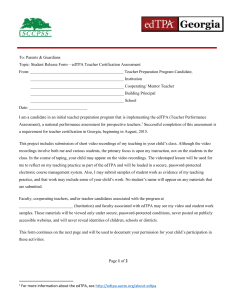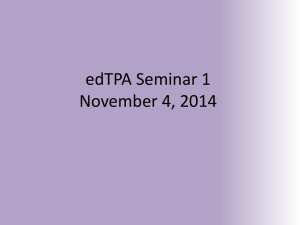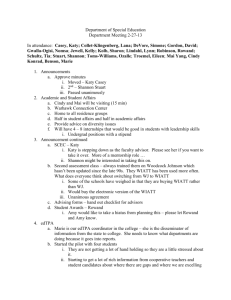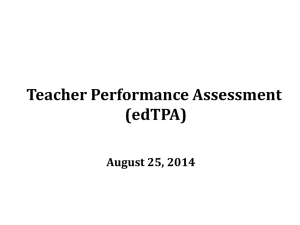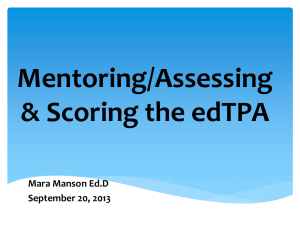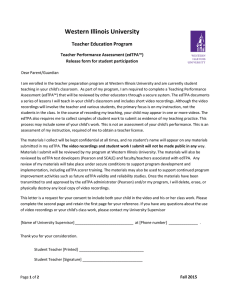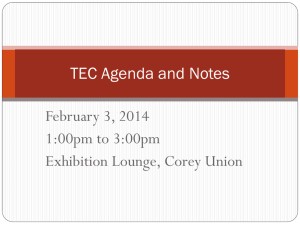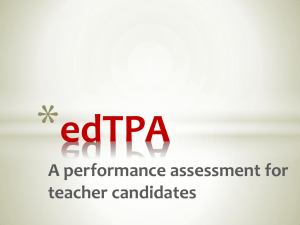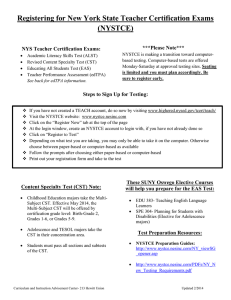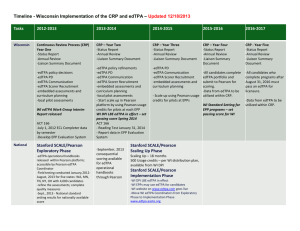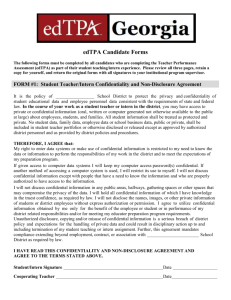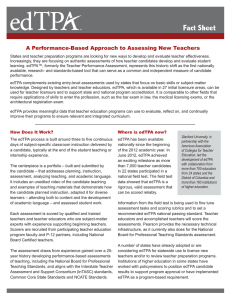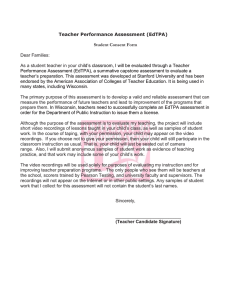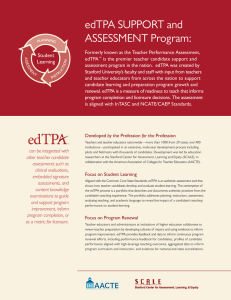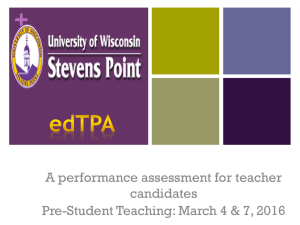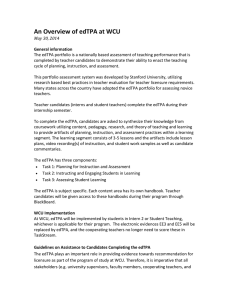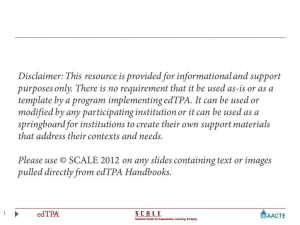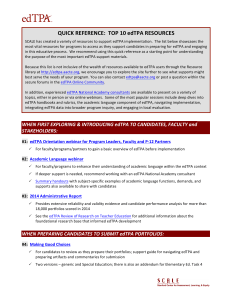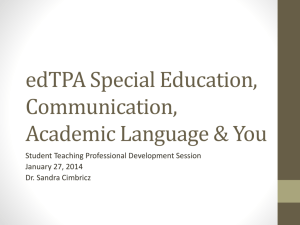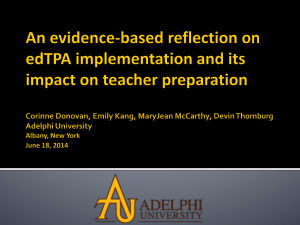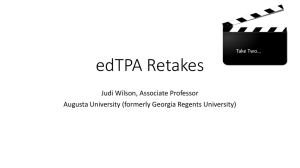edTPA: Impact on Teaching and Learning in a
advertisement
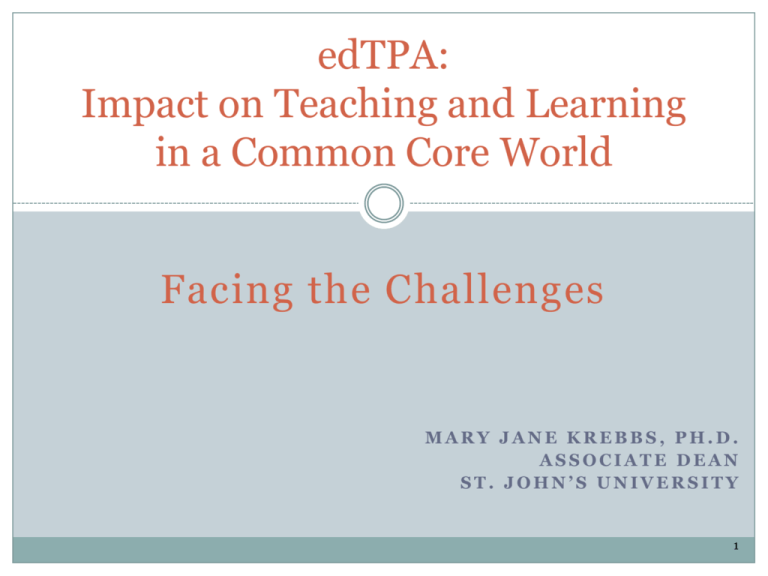
edTPA: Impact on Teaching and Learning in a Common Core World Facing the Challenges MARY JANE KREBBS, PH.D. ASSOCIATE DEAN ST. JOHN’S UNIVERSITY 1 Backdrop A learning goal or standard is only as good as the instructor’s ability to imagine what it would look like when it is being met. Sarah Fine Education Week 10/28/10 2 Backdrop We need to fix our schools to teach “entrepreneurship, innovation and creativity” so students can emulate the “new untouchables” in our workforce today. Thomas Friedman New York Times, Oct. 2009 Today’s students will need such tools (of creativity) to tackle the problems they stand to inherit…Knowledge will need to be combined across disciplines, and juxtaposed in unorthodox ways. Creativity: A Cure for the Common Core Dan Berrett The Chronicle of Higher Ed April 5, 2013 3 Have as your mantra: Explicit literacy instruction is now a shared responsibility of all teachers throughout a school. Ross Wiener Teaching to the Core CCSSO and the Aspen Institute March 2013 4 Content mastery is not sufficient. We should view content acquisition as a means to an end, not an end in itself. If students do not have numerous opportunities to use content knowledge to solve interesting problems, grapple with key questions and issues of the discipline, and examine sound issues, they will be unlikely to perform well on the common assessments. David Coleman Building on the Common Core Educational Leadership, March 2011 5 School of Education Challenges Prepare faculty, students, supervisors for the edTPA certification process Understand the Common Core Align Common Core, edTPA and our programs with the task prompts Align edTPA with our accreditation agency - TEAC 6 Curriculum Components Content: knowledge/skills/understandings depth over breadth ability to transfer interdisciplinary learning goal – it has to be about something writing, writing, writing Task I the intended teaching 7 Curriculum Components Instruction: “heartbeat” of Common Core use knowledge to… non-routine (cf: brain theory) creativity intrinsically motivated writing, writing, writing Task II the enacted teaching 8 Curriculum Components Assessment: integral – not intrusive “imagine what it looks like when being met” evidence of understanding Backward Design formative and summative writing, writing, writing Task III impact on student learning which informs further planning 9 Sample Prompts Describe how your planned formal and informal assessments will provide direct evidence that students can use the literacy strategy and requisite skills to comprehend or compose text throughout the learning segment. Explain how you elicited student responses to promote thinking… Use evidence from 3 student work samples and the whole class summary to analyze the patterns of learning for the whole class and differences for groups or individual learners… 10 Our students have to learn how to do this by our teaching them and by our modeling these components in our planning, teaching and assessing 11 12 NJDOE 12 What do these claims look like? Are teachers giving content area reading materials (Scientific texts, Historical texts, Art texts, Math texts) greater focus? Is academic vocabulary front and center in every subject and every grade? Is the teacher asking text-dependent questions? Are the questions posed by the teacher worth answering? Is the teacher facilitating evidence–based discussion and leading the students to draw from that evidence in their writing? Are all students actively participating? Is appropriate scaffolding given to raise the bar for all? Is the teacher providing immediate effective feedback? Adapted: Danielson & Marzano 13 Overview of Standards for History/Social Studies, Science, and Technical Subjects Reading Standards for History/Social Studies, Science, and Technical Subjects knowledge of domain-specific vocabulary analyze, evaluate, and differentiate primary and secondary sources synthesize quantitative and technical information, including facts presented in maps, timelines, flowcharts, or diagrams Writing Standards for History/Social Studies, Science, and Technical Subjects write arguments on discipline-specific content and informative/explanatory texts use of data, evidence, and reason to support arguments and claims use of domain-specific vocabulary 14 NJDOE 15 What do these claims look like? Is the teacher developing the students’ capacity to make sense of a multi-step problem and persevere in solving it? Do students understand the relationship between a real-world scenario, its mathematical representation and the strategy needed to solve it? Is academic vocabulary front and center? Can the students engage in a mathematical discourse? Can they express mathematical reasoning? Is the teacher developing the students’ capacity to use appropriate tools and to focus on precision? Are assignments coherently designed; are math exercises given in intentional sequences? Do assignments contain different types of problems that are presented in a simple to complex format? adapted: www.engageny.org 16 Coupling practice with content gives the learning context, whereas practices alone are activities, and content alone is memorization… The integration of rigorous content and application reflects how science and engineering is practiced in the real world Executive Summary New Generation Science Standards Facing the Challenges 1. Aspects of edTPA Coordinating Committee course/Program Design Sub-committee communication/Training Sub-committee infrastructure Sub-committee edTPA/TEAC rubric alignment Sub-committee 18 Facing the Challenges 2. Gap Analysis The Common Core State Standards are integrated throughout every course the way knowledge is learned and transferred reflections on learning assessing student work Instituted a new writing course: Writing for Educators co-taught by a content person and a literacy person same or different department Created a course, Educational Theory To Practice, taken with student teaching to assist students in the kind of reflection necessary for the effective cycle of teaching (intended; enacted; impact on student learning) 19 Facing the Challenges Assessment mantra: students are only limited by what it is we ask of them as proof that they know it. integrated into every course Backward Design looking at student work as a means toward student achievement, curriculum alteration and “learning more about what students know and can do and what they think” (Darling-Hammond and Falk, p. 6) thinking outside the box in designing assessment protocols Faculty Retreat: Where can the learning take place in preparation for the assessment of effective teaching (edTPA) 20 Facing the Challenges 3. Training Full Faculty Council: November 12, 2012 (Beverly Falk) and March 4, 2013 (in-house team of faculty) All Adjunct faculty in the Department of Curriculum and Instruction All Supervisors for student teachers 21 Facing the Challenges 4. Train the Trainer Professional Development Design Committee comprised of representatives from administration, faculty, adjuncts and supervisors from 2 campuses Two-day design process in August 2013 22 Facing the Challenges 5. edTPA Teaching Modules (2 hours each; offered at night and on Saturday) Academic Language Instruction Assessment Mathematics 23

